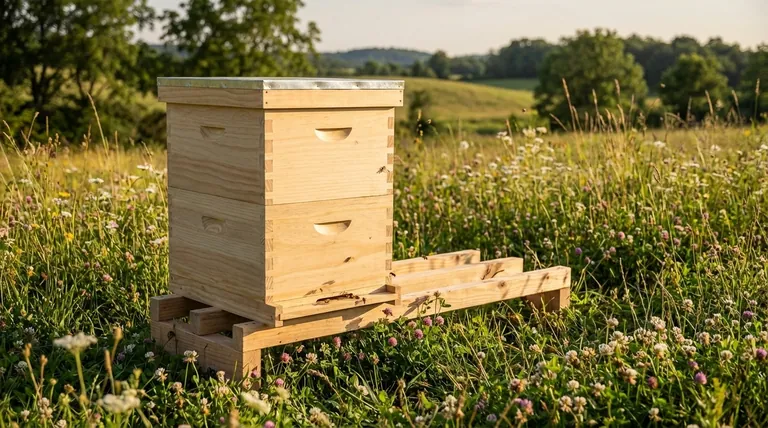At its core, a hive box is the central living quarters for a honeybee colony. More specifically known as a hive body or brood chamber, this is the protected space where the queen lays her eggs and the colony raises its young. It forms the heart of any modern beehive.
The hive box is not merely a container; it is the functional nursery, pantry, and living area of the colony. Understanding its role is the first step to successfully managing a healthy hive.

The Hive Box in the Context of a Full Hive
A hive box does not function in isolation. It is the central component in a modular system designed to support the colony's growth and facilitate management by the beekeeper.
The Foundation
A complete hive starts from the ground up. A hive stand elevates the entire structure, which keeps the hive dry, improves ventilation, and insulates it from the cold ground. The first wooden component placed on the stand is the bottom board, which serves as the floor and entrance for the hive.
The Core: The Brood Chamber
The hive box, or brood chamber, sits directly on top of the bottom board. This is the colony's primary domain. Inside, the bees build wax comb within frames where the queen lays eggs and worker bees raise the larvae and pupae—collectively known as brood. This box also contains stores of pollen and honey for the colony's immediate use.
The Expansion: Stacking Boxes
As a colony grows stronger, a beekeeper may add a second hive body on top of the first. This gives a powerful queen more room to lay and allows the colony to expand its population and food stores for winter.
Hive Body vs. Honey Super: A Critical Distinction
The term "hive box" can be confusing because there are two primary types of boxes in a hive, each with a distinct purpose.
The Hive Body: The Colony's Home
As established, the hive body is for the bees themselves. It is typically a "deep" box (9 5/8 inches tall) to provide ample space for the brood nest. The honey stored here is crucial for the colony's survival, especially through winter, and is not harvested by the beekeeper.
The Honey Super: The Beekeeper's Share
Honey supers are separate boxes placed on top of the hive body. These are intended for the bees to store surplus honey. Because the queen is typically kept in the brood chamber below (often by a screen called a queen excluder), these supers contain only honey. This is the honey that a beekeeper can safely harvest without harming the colony.
Common Pitfalls to Avoid
Understanding the role of the hive box is key to avoiding common beekeeping mistakes that can harm the colony's health and productivity.
Confusing the Brood and Honey Zones
Never harvest honey from the main hive body unless you are an expert beekeeper managing population dynamics. Taking the colony's primary food stores can lead to starvation, especially during winter or periods of nectar scarcity.
Providing Too Much or Too Little Space
Giving a small colony a massive space (like two deep hive bodies) can make it difficult for them to manage temperature and defend their home. Conversely, failing to add a second hive body or honey supers to a booming colony can cause them to run out of space, which is a primary trigger for swarming.
Making the Right Choice for Your Goal
The hive box is the foundational element of your beekeeping philosophy, directly impacting both the bees and your own physical effort.
- If your primary focus is traditional management and maximizing brood space per box: Use the standard setup of one or two "deep" hive bodies for the brood chamber.
- If your primary focus is minimizing heavy lifting and standardizing your equipment: Consider using all "medium" depth boxes for both the brood chamber and honey supers, though you will need more of them.
Ultimately, the hive box provides the essential structure that allows a beekeeper to work in partnership with the colony's powerful natural instincts.
Summary Table:
| Aspect | Hive Body (Brood Chamber) | Honey Super |
|---|---|---|
| Primary Purpose | Colony's living quarters (nursery & pantry) | Storage for surplus honey harvest |
| Key Contents | Brood (eggs, larvae), pollen, winter honey | Honey only |
| Harvesting | Not harvested (colony's food) | Harvested by the beekeeper |
| Typical Box Size | Deep (9 5/8") | Deep, Medium, or Shallow |
Ready to build or expand your apiary with the right equipment?
As a leading wholesale supplier to commercial apiaries and distributors, HONESTBEE provides the durable, high-quality hive boxes and beekeeping supplies you need to support healthy, productive colonies. Our wholesale-focused operations ensure you get the reliable equipment your business depends on.
Contact our team today to discuss your needs and get a quote.
Visual Guide

Related Products
- Australian Langstroth Beehive Boxes for Beekeeping Wholesales
- Langstroth Honey Bee Box Hive Boxes for Different Depths
- Langstroth Bee Hives Bee Keeping Box for Beginners Beekeeping
- HONESTBEE Professional Long Handled Hive Tool with Precision Cutting Blade
- Portable Bee Mating Hive Boxes Mini Mating Nucs 8 Frames for Queen Rearing
People Also Ask
- What are the three types of beehives? Find the Perfect Hive for Your Beekeeping Philosophy
- How many deep hive bodies should I use? The Standard for a Healthy, Winter-Ready Colony
- What other types of hives are available besides the Flow Hive? Explore Langstroth, Top Bar, and Warre
- What are the sizes of supers available in a standard hive? A Guide to Deep, Medium, and Shallow Boxes
- What is the purpose of reversing brood chambers in the spring? A Proactive Swarm Prevention Strategy



















